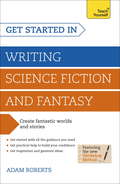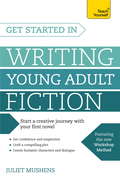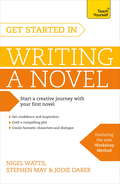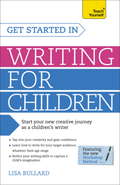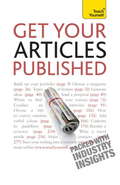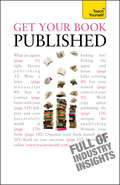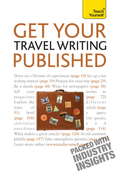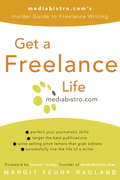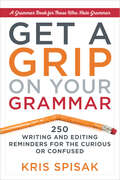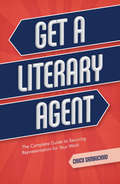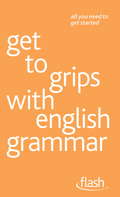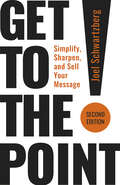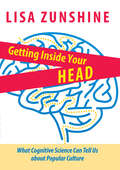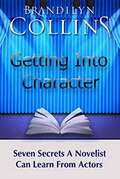- Table View
- List View
Get Started in Writing Science Fiction and Fantasy: How to write compelling and imaginative sci-fi and fantasy fiction
by Adam RobertsYOUR COMPLETE GUIDE TO WRITING AWESOME AND AMAZING FICTION FROM ANOTHER DIMENSION.This is an authoritative and engaging introduction to writing science fiction and fantasy for the complete beginner. This book provides all the information, guidance, and advice you need to write great science fiction to captivate your readers. It will help you understand how the genre works, the big dos and don'ts - as well as giving you the inspiration and motivation you actually need to write. Written by a leading science fiction novelist and a Professor in Creative Writing at the University of London - you'll discover how to let your creativity flow, create incredible worlds, and get your novel finished.ABOUT THE SERIESThe Teach Yourself Creative Writing series helps aspiring authors tell their story. Covering a range of genres from science fiction and romantic novels, to illustrated children's books and comedy, this series is packed with advice, exercises and tips for unlocking creativity and improving your writing. And because we know how daunting the blank page can be, we set up the Just Write online community at tyjustwrite, for budding authors and successful writers to connect and share.
Get Started in Writing Young Adult Fiction: How to write inspiring fiction for young readers
by Juliet MushensLearn how to write young adult fiction with imagination and verve.This is an authoritative and engaging introduction to writing young adult fiction for the complete beginner. It will help you understand how the genre works, the big do's and don't's - as well as giving you the inspiration and motivation you actually need to write. Written by a leading literary agent who knows what it takes to make it in this market, this book will give you the advice and tips you need to stand out. An essential book for anyone hoping to emulate the success and addictive qualities that characterize books like The Hunger Games, Twilight, Divergent and The Fault in Our Stars.ABOUT THE SERIESThe Teach Yourself Creative Writing series helps aspiring authors tell their story. Covering a range of genres from science fiction and romantic novels, to illustrated children's books and comedy, this series is packed with advice, exercises and tips for unlocking creativity and improving your writing. And because we know how daunting the blank page can be, we set up the Just Write online community at tyjustwrite, for budding authors and successful writers to connect and share.
Get Started in Writing a Novel: How to write your first novel and create fantastic characters, dialogues and plot
by Nigel Watts Stephen May Jodie DaberLEARN HOW TO WRITE YOUR FIRST NOVEL WITH THIS COMPREHENSIVE GUIDE.This new edition of an acclaimed guide to writing a novel helps you if you are just at the very beginning of your writing journey, showing you how to gain confidence and find inspiration. A classic book that has supported thousands of authors over the years, it contains a wealth of information on how to structure, craft and develop your writing, how to edit and redraft, and how to take the first steps towards publication. Each chapter contains a long and several shorter writing exercises, while key quotes, ideas and focus points will be clearly signposted and will summarise important concepts and advice. At the heart of each chapter is the 'Workshop'. The Workshop is a key exercise, in which you will gain a deeper insight into the craft of writingThis new edition also includes an expanded section on self- and digital-publishing, to reflect recent advances in technology and practice.ABOUT THE SERIESThe Teach Yourself Creative Writing series helps aspiring authors tell their story. Covering a range of genres from science fiction and romantic novels, to illustrated children's books and comedy, this series is packed with advice, exercises and tips for unlocking creativity and improving your writing. And because we know how daunting the blank page can be, we set up the Just Write online community at tyjustwrite, for budding authors and successful writers to connect and share.
Get Started in Writing a Novel: How to write your first novel and create fantastic characters, dialogues and plot
by Nigel WattsThis new edition of an acclaimed guide to writing a novel helps you if you are just at the very beginning of your writing journey, showing you how to gain confidence and find inspiration. A classic book that has supported thousands of authors over the years, it contains a wealth of information on how to structure, craft and develop your writing, how to edit and redraft, and how to take the first steps towards publication. Each chapter contains a long and several shorter writing exercises, while key quotes, ideas and focus points will be clearly signposted and will summarise important concepts and advice. At the heart of each chapter is the 'Workshop'. The Workshop is a key exercise, in which you will gain a deeper insight into the craft of writing This new edition also includes an expanded section on self- and digital-publishing, to reflect recent advances in technology and practice.
Get Started in Writing an Illustrated Children's Book: Design, develop and write illustrated children's books for kids of all ages
by Lucy CourtenayDo you have an irresistible idea for a children's book with pictures? Are you inspired by writers like Julia Donaldson and Lauren Child? Get Started in Writing and Illustrating A Children's Book is designed for anyone who wants to write in this genre of fiction, whatever the category or age range. Designed to build confidence and help fire up creativity, it is also an essential guide to mastering the practicalities of working with illustrators and illustrated concepts, from creating ideas for toddler board books to writing high concept middle grade projects. It carries the distinctive learning features of the flagship Teach Yourself Creative Writing series, with Snapshots designed to get you writing quickly, Key Idea to help crystallize thought, and a wealth of supplementary material, including insights into the publishing world and the role of the agent.
Get Started in Writing an Illustrated Children's Book: Design, develop and write illustrated children's books for kids of all ages
by Lucy CourtenayDo you have an irresistible idea for a children's book with pictures? Are you inspired by writers like Julia Donaldson and Lauren Child? Get Started in Writing and Illustrating A Children's Book is designed for anyone who wants to write in this genre of fiction, whatever the category or age range. Designed to build confidence and help fire up creativity, it is also an essential guide to mastering the practicalities of working with illustrators and illustrated concepts, from creating ideas for toddler board books to writing high concept middle grade projects. It carries the distinctive learning features of the flagship Teach Yourself Creative Writing series, with Snapshots designed to get you writing quickly, Key Idea to help crystallize thought, and a wealth of supplementary material, including insights into the publishing world and the role of the agent.
Get Started in Writing for Children: How to write entertaining, colourful and compelling books for children
by Lisa BullardLEARN HOW TO WRITE COMPELLING STORIES FOR CHILDREN.Get Started in Writing for Children will help you at the very beginning of the creative journey to gain confidence and find inspiration, and then support you in the completion of your first piece of children's literature, whether it's a picture book, a middle-grade story or a young adult novel. Each chapter includes a central writing exercise and four shorter ones, while key quotes, key ideas and focus points will be clearly signposted and will summarise important concepts and advice. At the heart of each chapter is the 'Workshop', a key exercise in which you will gain a deeper insight into the craft of writing for children. In addition to coverage of the key categories and their conventions, this book includes substantial information on getting established in the writing community, gathering a fan base and pitching your work to publishers.What are you waiting for? This book has all you need to get started.
Get Started in: Writing Science Fiction and Fantasy
by Adam RobertsThis is an authoritative and engaging introduction to writing science fiction and fantasy for the complete beginner. This book provides all the information, guidance, and advice you need to write great science fiction to captivate your readers. It will help you understand how the genre works, the big dos and don'ts - as well as giving you the inspiration and motivation you actually need to write. Written by a leading Science Fiction novelist and a Professor in Creative Writing at the University of London - you'll discover how to let your creativity flow, create incredible worlds, and get your novel finished.
Get Up, Meg!
by Cindy Peattie Anne Stribling A Corazon AbiertoTitle contained within StartUp Phonic Core Program. Not Sold Separately
Get Writing Children's Fiction: Ideas, Tips and Exercises for Writers of Children's Fiction
by Karen KingThe aim of this book is to get you writing. It's full of inspiration, tips and writing exercises for anyone who wants to write children's fiction. Included are tips from other published writers, useful links and answers to questions you've always wanted to ask.Includes chapters on:Know-how: the difference between writing for children and writing for adults.How to get ideas for your stories from your family, your work and your life - and how to expand those ideas.Creating believable characters children will love reading about.Writing by the seat of your pants, or plotting? Basic things you need to know for either approach.Writing realistic dialogue.Writing the first draftHow to create 'reel them in' beginnings, sustain the pace in the middle, and write satisfying endings. How to write page-turning chapter endings; keeping continuity when writing series. Writing for the educational market.Writing a synopsis and a proposal.Submitting your work to a publisher or agent.Dealing with rejects and rewrites.Publicity and marketing. Publishing your own work.
Get Writing Children's Fiction: Ideas, Tips and Exercises for Writers of Children's Fiction
by Karen KingThe aim of this book is to get you writing. It's full of inspiration, tips and writing exercises for anyone who wants to write children's fiction. Included are tips from other published writers, useful links and answers to questions you've always wanted to ask.Includes chapters on:Know-how: the difference between writing for children and writing for adults.How to get ideas for your stories from your family, your work and your life - and how to expand those ideas.Creating believable characters children will love reading about.Writing by the seat of your pants, or plotting? Basic things you need to know for either approach.Writing realistic dialogue.Writing the first draftHow to create 'reel them in' beginnings, sustain the pace in the middle, and write satisfying endings. How to write page-turning chapter endings; keeping continuity when writing series. Writing for the educational market.Writing a synopsis and a proposal.Submitting your work to a publisher or agent.Dealing with rejects and rewrites.Publicity and marketing. Publishing your own work.
Get Your Articles Published: How to write great non-fiction for publication
by Lesley Bown Lesley HudswellGet Your Articles Published is a practical step-by-step guide offering you the information you to learn about the market, requirements, practicalities and skills needed to write on a freelance basis for magazines, it covers all major genres from mainstream and lifestyle through to more specialised subject areas. With plenty of information on legalities and logistics, such as writing to deadlines, the material is also accompanied by a range of useful resources, from websites to books and relevant writers' societies. By the end of this book, you will know how to research not only your subject but also your target publication and its readers, benefit from insider hints and tips from industry professionals and learn how and what to submit and to whom.NOT GOT MUCH TIME?One, five and ten-minute introductions to key principles to get you started.AUTHOR INSIGHTSLots of instant help with common problems and quick tips for success, based on the author's many years of experience.TEST YOURSELFTests in the book and online to keep track of your progress.EXTEND YOUR KNOWLEDGEExtra online articles at www.teachyourself.com to give you a richer understanding of getting your articles published.FIVE THINGS TO REMEMBERQuick refreshers to help you remember the key facts.TRY THISInnovative exercises illustrate what you've learnt and how to use it.
Get Your Articles Published: Teach Yourself (TY Creative Writing)
by Lesley BownGet Your Articles Published is a practical step-by-step guide offering you the information you to learn about the market, requirements, practicalities and skills needed to write on a freelance basis for magazines, it covers all major genres from mainstream and lifestyle through to more specialised subject areas. With plenty of information on legalities and logistics, such as writing to deadlines, the material is also accompanied by a range of useful resources, from websites to books and relevant writers' societies. By the end of this book, you will know how to research not only your subject but also your target publication and its readers, benefit from insider hints and tips from industry professionals and learn how and what to submit and to whom. NOT GOT MUCH TIME? One, five and ten-minute introductions to key principles to get you started. AUTHOR INSIGHTS Lots of instant help with common problems and quick tips for success, based on the author's many years of experience. TEST YOURSELF Tests in the book and online to keep track of your progress. EXTEND YOUR KNOWLEDGE Extra online articles at www.teachyourself.com to give you a richer understanding of getting your articles published. FIVE THINGS TO REMEMBER Quick refreshers to help you remember the key facts. TRY THIS Innovative exercises illustrate what you've learnt and how to use it.
Get Your Book Published: Teach Yourself (Teach Yourself General Ser.)
by Katherine LapworthThis new book gives you everything you need to know to get into print. Whether you are seeking an agent or publisher, or have decided to self-publish, it gives you the background information, step-by-step guides and a unique selection of case studies from published authors and insider tips from industry experts. With an exhaustive list of useful addresses and websites, it is an essential manual for any aspiring author. Features contributions from key literary agencies (including Curtis Brown and Pollinger) and top publishing companies (including John Murray and Headline). NOT GOT MUCH TIME? One, five and ten-minute introductions to key principles to get you started. AUTHOR INSIGHTS Lots of instant help with common problems and quick tips for success, based on the author's many years of experience. TEST YOURSELF Tests in the book and online to keep track of your progress. EXTEND YOUR KNOWLEDGE Extra online articles at www.teachyourself.com to give you a richer understanding of getting your book published. FIVE THINGS TO REMEMBER Quick refreshers to help you remember the key facts. TRY THIS Innovative exercises illustrate what you've learnt and how to use it.
Get Your Book Published: Teach Yourself (Teach Yourself General Ser.)
by Katherine LapworthThis new book gives you everything you need to know to get into print. Whether you are seeking an agent or publisher, or have decided to self-publish, it gives you the background information, step-by-step guides and a unique selection of case studies from published authors and insider tips from industry experts. With an exhaustive list of useful addresses and websites, it is an essential manual for any aspiring author. Features contributions from key literary agencies (including Curtis Brown and Pollinger) and top publishing companies (including John Murray and Headline).NOT GOT MUCH TIME?One, five and ten-minute introductions to key principles to get you started.AUTHOR INSIGHTSLots of instant help with common problems and quick tips for success, based on the author's many years of experience.TEST YOURSELFTests in the book and online to keep track of your progress.EXTEND YOUR KNOWLEDGEExtra online articles at www.teachyourself.com to give you a richer understanding of getting your book published.FIVE THINGS TO REMEMBERQuick refreshers to help you remember the key facts.TRY THISInnovative exercises illustrate what you've learnt and how to use it.
Get Your Travel Writing Published: Perfect your travel writing and share it with the world (Teach Yourself Creative Writing Ser.)
by Cynthia DialGet Your Travel Writing Published will give those of you who love to travel and long to write about it the essential tools to turn it into a profession. By the end of this book, you will know what steps you will need to take to get your work published, the ABCs of writing winning travel articles and the markets available to you, all while avoiding common beginner's pitfalls.NOT GOT MUCH TIME?One, five and ten-minute introductions to key principles to get you started.AUTHOR INSIGHTSLots of instant help with common problems and quick tips for success, based on the author's many years of experience.TEST YOURSELFTests in the book and online to keep track of your progress.EXTEND YOUR KNOWLEDGEExtra online articles at www.teachyourself.com to give you a richer understanding of getting your travel writing published.FIVE THINGS TO REMEMBERQuick refreshers to help you remember the key facts.TRY THISInnovative exercises illustrate what you've learnt and how to use it.
Get a Freelance Life
by Margit Feury Ragland Laurel ToubyWrite Your Own Check. Considering a career in freelance writing? Already a freelancer but seeking practical, solid advice on the basics of the business? Get a Freelance Life is the complete guide to all aspects of a freelance writing career, straight from the creators of mediabistro.com--the nation's most connected, authoritative source for media professionals. Learn how to:* Write compelling pitch letters * Network with the best in the magazine and newspaper industry* Understand the freelance market and detect its changes* Self-edit and rewrite your work* Manage tight deadlines* Negotiate contracts* Survive the financial ups and downs of the freelance lifeWith plenty of insider advice and tips from the most successful freelance writers and editors in the country, Get a Freelance Life is a must-have resource for turning your freelance gigs into a full-fledged writing career. From the Trade Paperback edition.
Get a Grip on Your Grammar: 250 Writing and Editing Reminders for the Curious or Confused
by Kris Spisak“A useful reference [and] a fun read, chock-full of telling examples and pop-culture references.” —Charles Euchner, author of Keep It ShortMost of us are not poets or novelists, but we are all writers. We email, text, and post; we craft memos and reports, menus and outdoor signage, birthday cards and sticky notes on the fridge. And just as we should think before we speak, we need to think before we write.Get a Grip on Your Grammar is a grammar book for those who hate grammar books, a writing resource filled with quick answers and a playful style—not endless, indecipherable grammar jargon. Designed for student, business, and creative-writing audiences alike, its easily digestible writing tips will finally teach you:• How to keep “lay” and “lie” straight• The proper usage of “backup” versus “back up”• Where to put punctuation around quotation marks• The meaning of “e.g.” versus “i.e.”• The perils of overusing the word “suddenly”• Why apostrophes should not be thrown about like confetti and 244 more great tips
Get a Literary Agent: The Complete Guide to Securing Representation for Your Work
by Chuck SambuchinoThe Ultimate Guide to Getting a Literary Agent! If you dream of scoring the best possible deal with a traditional publisher and seeing your book in print, you need literary representation. Filled with practical, straightforward advice and insider tips, Get a Literary Agent is a one-stop resource for writers of both fiction and nonfiction. You'll learn how to: Research agents and target the best ones for your work Navigate the submission process--from best practices to possible pitfalls Craft a polished query letter and pitch your work effectively Assemble a book proposal like a pro Form a lasting partnership with your agent You'll also gain the advice of more than 100 literary agents who share their secrets for securing representation. If you've ever wondered what a literary agent can do for you--and why you need one--this invaluable guide provides the answers.
Get to Grips with English Grammar: Flash
by Ron SimpsonThe books in this bite-sized new series contain no complicated techniques or tricky materials, making them ideal for the busy, the time-pressured or the merely curious. Get To Grips With English Grammar is a short, simple and to-the-point guide to English grammar. In just 96 pages, the reader will learn all they need to write clear, correct English. Ideal for the busy, the time-pressured or the merely curious, Get To Grips With English Grammar is a quick, no-effort way to break into this fascinating topic
Get to grips with english grammar: Flash
by Ron SimpsonThe books in this bite-sized new series contain no complicated techniques or tricky materials, making them ideal for the busy, the time-pressured or the merely curious. Get To Grips With English Grammar is a short, simple and to-the-point guide to English grammar. In just 96 pages, the reader will learn all they need to write clear, correct English. Ideal for the busy, the time-pressured or the merely curious, Get To Grips With English Grammar is a quick, no-effort way to break into this fascinating topic
Get to the Point!, Second Edition: Simplify, Sharpen, and Sell Your Message
by Joel SchwartzbergDeliver razor-sharp points in all of your work communications! This updated classic enables you to captivate any audience, create meaningful impact, and make your words matter.Every time you communicate, you're trying to move someone to feel, think, and act. You're trying to make a point. But very few communicators-regardless of their purpose or position-know their points, have true points, or even understand what a point is, rendering themselves pointless.In this expanded second edition of the bestselling Get to the Point!, Joel Schwartzberg draws on his decades of experience as a strategic communications executive and public speaking coach to deliver a masterclass in high-impact communications for the digital age. The new edition features a substantial amount of new content, including surprising research, real-world insight, and actionable tips that meet the modern needs of professionals up and down the organizational chart.Using his trademark encouraging and often humorous voice, Schwartzberg helps you:•Understand the Power of Points: Learn how points outperform topics, themes, and observations.•Identify and Elevate Your Key Points: Create impactful speeches and slide presentations, emails and work chats, and Zoom and in-person meeting communications•Distill Complex Ideas: Transform complicated concepts into crystal-clear messages.•Boost Leadership Perceptions: Enhance impressions of competence and confidnce.•Hook Audiences: Start and finish with compelling openings and closings.•Tell Impactful Stories: Use stories, examples, and data in a way that highlights your points, not distract from them.•Conquer Public Speaking Jitters: Use proven techniques to stay calm and in control•Leverage AI Tools: Use artificial intelligence to support-not replace-effective communication•Avoid Common Pitfalls: Sidestep the landmines that derail most communicators.Whether you're a C-suite executive, salesperson, scientist, or student, Get to the Point! is a blueprint for evolving your written and spoken communications from informing to inspiring and pointless to powerful.Don't just share ideas and make an impression. Champion your points and make a difference!
Getting Inside Your Head: What Cognitive Science Can Tell Us about Popular Culture
by Lisa ZunshineUsing the psychological concept called theory of mind, Lisa Zunshine explores the appeal of movies, novels, paintings, musicals, and reality television.Winner of the CHOICE Outstanding Academic Title of the Choice ACRLWe live in other people's heads: avidly, reluctantly, consciously, unaware, mistakenly, and inescapably. Our social life is a constant negotiation among what we think we know about each other's thoughts and feelings, what we want each other to think we know, and what we would dearly love to know but don't.Cognitive scientists have a special term for the evolved cognitive adaptation that makes us attribute mental states to other people through observation of their body language; they call it theory of mind. Getting Inside Your Head uses research in theory of mind to look at movies, musicals, novels, classic Chinese opera, stand-up comedy, mock-documentaries, photography, and reality television. It follows Pride and Prejudice’s Mr. Darcy as he tries to conceal his anger, Tyler Durden as he lectures a stranger at gunpoint in Fight Club, and Ingrid Bergman as she fakes interest in horse races in Notorious.This engaging book exemplifies the new interdisciplinary field of cognitive cultural studies, demonstrating that collaboration between cognitive science and cultural studies is both exciting and productive.
Getting Into Character: Seven Secrets a Novelist Can Learn From Actors
by Brandilyn CollinsWant to bring characters to life on the page as vividly as fine actors do on the stage or screen? Getting Into Character will give you a whole new way of thinking about your writing. <p><p>Drawing on the Method Acting theory that theater professionals have used for decades, this in-depth guide explains seven characterization techniques and adapts them for the novelist’s use. You’ll discover concepts that will lead you to understand and communicate the motivation and psychology of all your characters. <p><p> These highly effective techniques will help you:<p> ~ create characters whose distinctive traits become plot components <p> ~ determine each character’s specific objectives and motivations <p> ~ write natural, meaningful dialogue that moves the story forward <p> ~ endow your characters with three-dimensional emotional lives <p> ~ use character motivation to bring action sequences to exuberant life <p> ~ write convincingly about any character facing any circumstance <p><p> EDITION 2: Revised and with new added material, gathered through 13 years of teaching these concepts at writers conferences.
